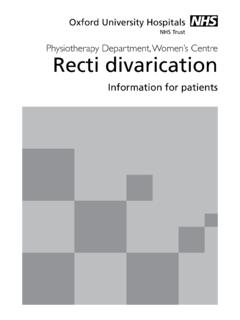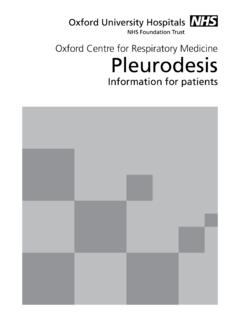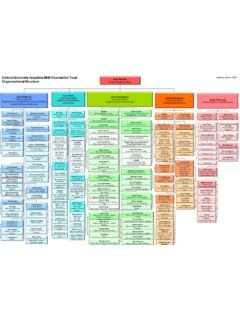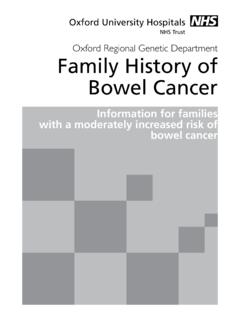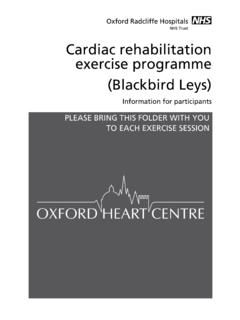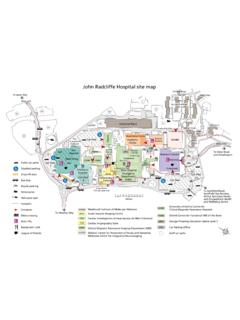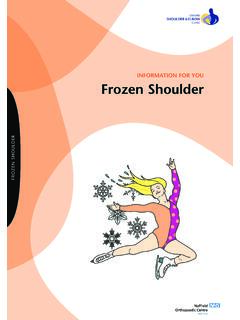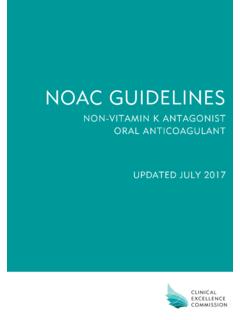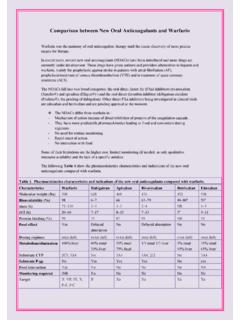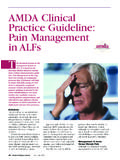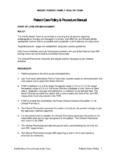Transcription of MM II LL - ouh.nhs.uk
1 Medicines Management and Therapeutics Committee January 2018 Oxford University Hospitals L L M M I I Volume 8 , No. 1 January 2018 This Medicines Information Leaflet is produced locally to optimise the use of medicines by encouraging prescribing that is safe, clinically appropriate and cost-effective to the NHS. Treatment of venous thromboembolism (VTE) with apixaban or rivaroxaban in adults This guideline sets out the use of apixaban and rivaroxaban in the acute treatment and secondary prevention of venous thromboembolism (VTE), both deep vein thrombosis (DVT) and pulmonary embolism (PE). Both oral anticoagulants are direct inhibitors of factor Xa with apixaban being our agent of choice. Choice of anticoagulant drug Treatment of DVT and PE can be with one of the following options: 1. Warfarin Warfarin may be preferred by some patients on the basis that there are decades of experience and an antidote.
2 It is preferred in patients with liver dysfunction or significant renal impairment. It can also be an advantage to have a monitored treatment in the poorly compliant. For further information see MIL volume 5, number 8. 2. Factor Xa inhibitors Apixaban and rivaroxaban are convenient for initiation of treatment as the quick onset of action negates the need for parenteral therapy. The efficacy of apixaban and rivaroxaban are similar to that of warfarin for acute VTE. However, compared to warfarin, both are significantly less likely to cause major bleeding. Additionally, apixaban is significantly less likely to cause clinically relevant non-major bleeding. Rivaroxaban (but not apixaban) had an increased risk of GI bleeding compared with warfarin. When used for long-term secondary prevention the prophylactic dose of apixaban ( mg bd) had no more bleeding than placebo.
3 The treatment dose of rivaroxaban (20 mg od) had a significantly increased risk of bleeding over placebo but the prophylactic dose (10 mg od) has been shown to be similarly effective and has a bleeding risk similar to aspirin. Although the Summary of Product Characteristics (SPCs) do not have an upper limit for body weight, the International Society on Thrombosis and Haemostasis (ISTH) suggest that DOACs should not be used in patients with a weight of more than 120kg. This is because there are limited clinical data available for patients at the extreme of weight, and the available pharmacokinetic/pharmacodynamic evidence suggests that decreased drug exposures, reduced peak concentrations and shorter half-lives occur with increasing weight, which raises concerns about under-dosing. 3. Dalteparin Dalteparin remains the gold standard treatment for cancer-related VTE and further information is available in MIL volume 7, number 10.
4 Whilst it is recognised that dabigatran (an oral thrombin inhibitor) and edoxaban (a factor Xa inhibitor) are also licensed for VTE they are not considered within these guidelines because they are deemed a less practical option; parenteral anticoagulation for at least five days is required before dabigatran or edoxaban can be initiated. Contraindications to anticoagulation The following substantially increase the risk of major bleeding: Current or recent gastrointestinal ulceration Presence of malignant neoplasm at high risk of bleeding Recent brain or spinal injury Recent brain, spinal or ophthalmic surgery Recent intracranial haemorrhage Known or suspected oesophageal varices Arteriovenous malformation Vascular aneurysms, major intraspinal or intracerebral vascular abnormalities Acute stroke (contact stroke team) Medicines Management and Therapeutics Committee January 2018 Oxford University Hospitals If anticoagulation is felt to be contraindicated, the patient should be discussed with Haematology (bleep 5529) and an IVC filter considered.
5 Starting apixaban and rivaroxaban and therapy Prior to starting treatment, a baseline coagulation screen, full blood count, U&Es (including renal function) and liver function must be performed. Table 1 provides guidance on the recommended doses. Patients should be started on a therapeutic dose of anticoagulation if diagnostic investigations are suspected to take longer than 1 hour (PE) or 4 hours (DVT). It will usually be simplest to give a treatment dose of dalteparin to provide 24 hours of cover. If the risk of therapy is felt to outweigh the benefit, this should be documented in the medical notes. Table 1: Dosing advice for apixaban and rivaroxaban Apixaban Rivaroxaban Standard Dose Days 1-7: 10mg bd Days 8 onwards: 5mg bd After 6 months: bd* (see below) Days 1-21: 15mg bd with food Day 22 onwards: 20mg od with food After 6 months, 10mg od* (see below) Renal impairment Warfarin preferred if CrCl less than 30ml/min Do not use if CrCl less than15ml/min Warfarin preferred if CrCl less than 30ml/min Do not use if CrCl less than 15ml/min Day 22 onwards if CrCl 30-49ml/min; consider reducing to 15mg od if the patient s risk of bleeding outweighs the risk of recurrence Hepatic impairment Contraindicated in patients with hepatic disease associated with coagulopathy and clinically relevant bleeding risk.
6 Use with caution in mild and moderate hepatic impairment (Child Pugh A or B). Not recommended in severe hepatic impairment. Contraindicated in patients with hepatic disease associated with coagulopathy and clinically relevant bleeding risk including cirrhotic patients with Child Pugh B and C. Switching from dalteparin Apixaban should be started instead of the next scheduled administration of dalteparin (if a patient has receives 7 days or more of dalteparin, then apixaban can be started at 5mg bd (as for day 8 onwards). Rivaroxaban should be started instead of the next scheduled administration of dalteparin Switching to dalteparin Give the first dose of dalteparin at the time the next apixaban dose would have been due Give the first dose of dalteparin at the time the next rivaroxaban dose would have been due Switching from warfarin Stop warfarin and start apixaban once INR is less than 2 Stop warfarin and start rivaroxaban once INR or less (not forgetting higher initial dosing when within three weeks of an acute event) Switching to warfarin Co-administer apixaban and warfarin for 2 days.)
7 After 2 days, check INR prior to next apixaban dose and continue until INR 2 or greater Co-administer rivaroxaban and warfarin until INR 2 or greater. *For patients taking long-term apixaban or rivaroxaban as secondary prevention the manufacturers indicates the dose should be reduced following completion of 6 months of treatment. A risk-benefit assessment might suggest that this decrease in dose could take place after 3 months. For rivaroxaban in patients in whom the risk of recurrent DVT or PE is considered high continuing 20 mg once daily should be considered. Although not licenced continuing 5 mg bd apixaban could also be considered in this group. 3 Medicines Information Leaflet Missed doses 1. Apixaban If a dose is missed, the patient should take the apixaban immediately and then continue with twice daily intake as before. 2. Rivaroxaban If a dose is missed during the 15 mg twice daily treatment phase (day 1 - 21), the patient should take the missed dose immediately and take the next dose on time (if the next dose is due two 15 mg tablets can be taken together).
8 The patient should then continue with 15 mg twice daily. If a dose is missed during the once daily treatment phase (day 22 and onwards), the patient should take the missed dose immediately, and continue on the following day with the once daily intake as recommended. The dose should not be doubled within the same day to make up for a missed dose. Interactions The use of factor Xa inhibitors is not recommended in patients receiving concomitant systemic treatment with azole-antimycotics (such as ketoconazole, itraconazole, voriconazole and posaconazole) or HIV protease inhibitors (such as ritonavir). These active substances are strong inhibitors of both CYP3A4 and P-gp and therefore may increase apixaban and rivaroxaban plasma concentrations to a clinically relevant degree. Co-administration of factor Xa inhibitors with strong CYP3A4 inducers rifampicin, phenytoin, carbamazepine, phenobarbital or St.
9 John s Wort, may lead to reduced apixaban and rivaroxaban plasma concentrations. We therefore recommend that strong CYP3A4 inducers should not be co-administered with factor Xa inhibitors when treating acute venous thromboembolism. Macrolide antibiotics, such as clarithromycin and erythromycin, may inhibit metabolism of factor Xa inhibitors and therefore caution should be applied if co-prescribed. Co-administration of rivaroxaban with dronedarone should be avoided given limited clinical data. Care should also be taken if patients are treated concomitantly with medicinal products affecting haemostasis ( NSAIDS, aspirin, platelet aggregation inhibitors or other antithrombotic agents). Further information for cardiac patients, can be found in MIL Vol 8, No 5. Concomitant treatment with unfractionated heparin (UFH), dalteparin or fondaparinux is contraindicated (except when UFH is being used to maintain patency of a central venous or arterial catheter) Monitoring Patients with poor compliance need careful assessment.
10 INR monitoring enables assessment of compliance with warfarin and therefore is the preferred option in such patients. Given no monitoring is required for DOACs, assessment and reinforcement of compliance do not take place. In addition, the anticoagulant effects from DOACs wear off much quicker than those of warfarin due to a much shorter half-life. Pregnancy & Breast feeding Apixaban and rivaroxaban should be avoided in pregnant patients and those who are breast feeding. Women of child-bearing potential should be counselled appropriately. Duration of therapy Patients with proximal DVT or PE should be treated for at least 3 months. For a first proximal DVT or a PE associated with transient risk factors treatment will usually stop at three months. Long term treatment will be considered for recurrent thrombosis, patients with an on-going risk factor, or unprovoked proximal DVT or PE.
